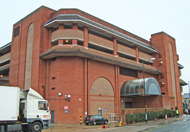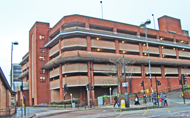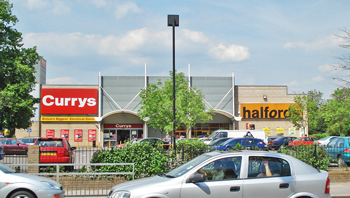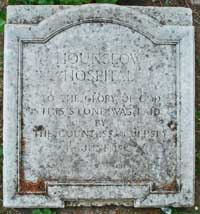General, acute
In 1875 a Cottage Hospital opened in Bell Road, Hounslow. It had been founded the previous year by Dr. L. de B. Christian.
In 1913 it moved to a new 2-storey purpose-built building in Staines Road. It had 20 beds. The Hospital Committee appointed a woman to act as a dispenser in the new Hospital, an innovation at the time.
During the 1920s the Hospital was extended and, in 1927, when it had 54 beds, a new Out-Patients Department and X-ray Department were completed and officially opened by Lady Joynson-Hicks. The Hospital was dealing with a large number of road traffic accidents, mainly from the Great West Road, placing a great strain on the staff.
As with all voluntary hospitals, fund-raising played an important part in the Hospital's activities, but in 1927 "Pluvius became a most unwelcome guest and 'reigned' supreme" (in other words, it rained), causing an estimated loss of some £600 in income from the outdoor fete. The Hospital was supported by the local population with gifts of eggs, fruit, vegetables and various useful items, and comforts for the patients. A silver paper collection raised £14 13 10d (£14.69).
On the wards, breakfast had to be cleared away and the wards cleaned and put in order by 9 o'clock. In the evenings, patients had to be in bed by 8 o'clock. No member of the nursing or domestic staff was allowed to leave the Hospital without the permission of the Matron. Ordinary patients paid 2 guineas (£2.10) a week, while private patients paid 6 gns (£6.30). In 1927 the cost of an in-patients per week was £2 6s 5d (£2.32), compared to £2 1s 4d (£2.07) in 1926. Out-patients paid 6d (less than 3p) for each attendance.
The Hospital excluded pregnant women from admission except in extraordinary cases, for example, in accidents or if surgical operation was required. Also ineligible were patients with mental disorders, epilepsy, infectious diseases, confirmed TB or incurable conditions.
The most common operations carried out at the Hospital were appendectomy, turbinectomy, hernia repair, laparotomy, mastectomy and various gynaecological procedures (ovariotomy, hysterectomy, dilatation and curettage, and salpingectomy).
In 1928 the Hospital had 60 beds and the cost per in-patient per week was £2 3s (£2.15). A new boiler had to be installed at a cost of £207 15s (£207.75) and a new steriliser purchased for £168 15s (£168.75). The additional sum of £643 15s 4d (£643.77) had to be found for the new Out-Patients Department. It was also decided to enlarge the Nurses' Home at a cost of £3,502 to rehouse the four nurses sleeping in a small iron building and two in rooms in private houses.
By 1936 the Hospital had 72 beds.
During WW2 the Hospital became part of the Emergency Medical Scheme (EMS). It had 97 beds, 30 of which were EMS beds.
In 1945, at the end of the war, the Hospital had 74 beds and 23 EMS beds. Plans were made for an extension which would contain wards (bringing the bed complement up to 150), a new main kitchen, staff dining rooms, a new operating theatre and new Out-Patients and Casualty Departments. In the same year, the 'father of Hounslow Hospital', Dr L. de B. Christian, died.
The Rotarians donated Rotary House (which had been used as a recreation centre for members of the Armed Forces) to the Hospital in 1945 and it was converted into a Nurses' Training School, also to be used by the Hospital for social evenings.
In 1948 the Hospital joined the NHS under the control of the Staines Group Hospital Management Committee, part of the North West Metropolitan Regional Hospital Board.
By 1954 the Hospital had been extended with the addition of three single-storey wards - one for men, one for women and one for children. It had 81 beds.
In July 1961 a new Out-Patients Department and Physiotherapy Department were opened.
Following a major reorganisation of the NHS in 1974, the Hospital was transferred to the control of the Hounslow District Health Authority, part of the North West Thames Area Health Authority.
The Hospital closed in 1977, but the Health Service unions occupied the buildings for some weeks afterwards in protest against the withdrawal of services.
Present status (May 2008)
The Hospital remained empty for several years and was finally demolished during the late 1980s.
The site is now a small industrial park containing Currys and Halfords retail units. Clipstone House on the opposite side of Hospital Road, once part of the Hospital complex, was also demolished and its site now contains an Aldi supermarket.


The site of the first Cottage Hospital on the corner of Bell Road (left) and Grove Road (right) is now a multi-storey car park.

The site of the second Hounslow Hospital in Staines Road.

The foundation stone for the Hospital, laid by the Countess of Jersey on 1st June 1912, is located in the History Garden of the West Middlesex University Hospital.
(Author unstated) 1913 Reflections from a Board Room mirror. British Journal of Nursing, 5th April, 273.
(Author unstated) 1977 From the Council. Patients' rights. British Medical Journal 2 (6095), 1165.
Scrutator 1978 The week. British Medical Journal 2 (6142), 969.
http://democraticservices.hounslow.gov.uk
www.aim25.ac.uk
www.british-history.ac.uk
www.francisfrith.com
Return to home page